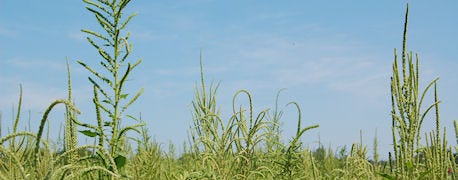June 12, 2013

It can be tough to tell the difference between Palmer amaranth and waterhemp.
Still, University of Illinois weed specialist Aaron Hager says identifying the weed is key to controlling these weeds. Proper identification leads to proper treatment, which helps protect yield potential.
Hager notes the two weeds look extremely similar in their early vegetative stages.
"During the 1990s, waterhemp provided an excellent example of how difficult it can be to differentiate among the various Amaranthus species, especially when plants are small," he adds.

Telling Palmer Amaranth From Waterhemp Can Be Tough This Early
To help, U of I is asking farmers to send in suspected Palmer amaranth plants. In the lab, they'll use molecular biology to determine whether the plant is Palmer amaranth or another Amaranthus species. Information on how to collect and submit tissue samples from suspected Palmer amaranth plants is described on the Palmer amaranth identification form, found at http://tinyurl.com/k34z3yf. Download the form, provide as much information as possible, and submit it along with the tissue samples to the address listed at the top of the form.
"Proper management of Palmer amaranth populations can help reduce the potential for seed production that will augment the soil seedbank and perpetuate the population in future growing seasons," Hager says.
Moving to Illinois
Palmer amaranth (Amaranthus palmeri) is a summer annual broadleaf weed species taxonomically related to other pigweed species (waterhemp, smooth, redroot) common in Illinois agronomic cropping systems. Palmer amaranth is not indigenous to Illinois, but rather it evolved as a desert-dwelling species in the southwestern U.S., including areas of the Sonoran Desert, Hager says.
"Genotypic and phenotypic adaptability have allowed Palmer amaranth to expand its distribution and colonize the vastly different agricultural landscapes across much of the eastern half of the United States, including Illinois," he explains.
~~~PAGE_BREAK_HERE~~~
Research has demonstrated that Palmer amaranth has a higher growth rate and is more competitive than other pigweed species.
"Growth rates approaching 3 inches per day and yield losses of 78% (soybean) and 91% (corn) attributed to Palmer amaranth interference have been reported in the scientific literature," Hager notes. "Seed production capability of female Palmer amaranth plants is similar to that of female waterhemp plants."
Identifying characteristics
Hager described the cotyledon leaves of Palmer amaranth as being relatively long compared with other Amaranthus species.
"Like all weedy Amaranthus species in Illinois, the true leaves—those produced after the cotyledon leaves—of Palmer amaranth have a small notch in the tip," he adds.
Occasionally, a single hair can be found in the leaf notch. This hair may not be present in each leaf notch of a Palmer amaranth plant, and tends to be less common on leaves of waterhemp plants. The stems and leaves have no or few hairs and the stems feel smooth to the touch.
"Leaves alternate on the stem and are generally lance-shaped or egg-shaped with prominent white veins on the underside," he adds. "As plants become older, they often assume a poinsettia-like appearance and sometimes have a white or purple chevron on the leaves. Leaves are attached to the stem by petioles that are usually longer than the leaf blade."
Source: University of Illinois
You May Also Like




